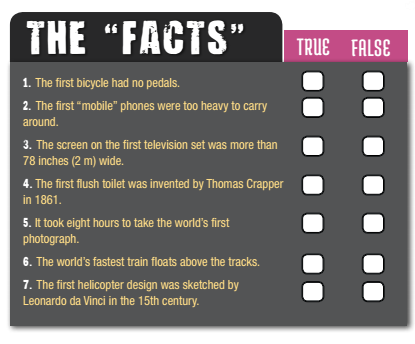Published in 2017 by Enslow Publishing, LLC.
101 W. 23rd Street, Suite 240, New York, NY 10011
Published in 2017 by Enslow Publishing, LLC, by permission of the Readers Digest Association Inc., 44 South Broadway, White Plains, New York, 10601
Copyright 2011 by Michael OMara Books Limited.
No part of this book may be reproduced by any means without the written permission of the publisher.
Library of Congress Cataloging-in-Publication Data
Names: Payne, Jan. | Wilder, Steven.
Title: Penicillin was discovered by accident : and other facts about inventions and discoveries / Jan Payne and Steven Wilder.
Description: New York, NY : Enslow Publishing, 2017. | Series: True or false? | Audience: Age 8-up. | Audience: Grade 4 to 6. | Includes bibliographical references and index.
Identifiers: LCCN 2016005253| ISBN 9780766077423 (library bound) | ISBN 9780766077393 (pbk.) | ISBN 9780766077409 (6-pack)
Subjects: LCSH: Inventions--History--Juvenile literature. | Technology--History--Juvenile literature. Classification: LCC T48 .P39 2017 | DDC 609--dc23 LC record available at http://lccn.loc.gov/2016005253
Printed in the United States of America
To Our Readers : We have done our best to make sure all website addresses in this book were active and appropriate when we went to press. However, the author and the publisher have no control over and assume no liability for the material available on those websites or on any websites they may link to.
Any comments or suggestions can be sent by e-mail to .
Cover illustration by Joel R. Gennari Interior illustrations by Paul Moran
Photo credits: maodoltee/Shutterstock.com (backgrounds throughout book); Nobelus/Shutterstock. com (dingbat on spine).
D id you know the first bicycle had no pedals? That scientists have reproduced the big bang in a lab? Or that medieval barbers performed surgery? Or did they? This book is full of fascinating facts and fat fibsand its up to you to decipher which is which.
From facts about historical figures, events, and even creatures, you will have a great time testing your knowledge, while learning some astonishing truths and uncovering some large lies along the way. Then check out the shocking facts that follow to see if your lie-detecting skills are up to snuff.
IT S UP TO YOU
Heres how it works. Each section contains a list of facts. On a separate sheet of paper, mark your answers to each fact. Then turn to page 44 to see if youre a science supreme!
So what are you waiting for? Grab a pencil and some paper and see if you can spot the twisted truths. Why not test your family and friends to see if they know the facts? You never know! You may surprise them with some of the stranger-than-fiction truths waiting to amaze you on these fun-packed pages.
Humans have been toying with technology for centuriesfrom the first tools used by cave dwellers to the latest gadgets. Decide whether the following facts are technologically true or fundamentally false. Keep track of your answers on a separate sheet of paper.
1. THE FIRST BICYCLE HAD NO PEDALS.
true
One of the first bicycles was invented in 1790. It was made from wood but had no steering or pedals. The rider sat astride it and moved by pushing their feet along the ground. In 1817 Karl Drais improved it with his running bicycle," which could be steered. A blacksmith named Kirkpatrick MacMillan added pedals in 1839. The design was further improved later that century by the addition of a chain and pneumatic (air-filled) tires, which led to the bicycle becoming safer and very popular.
2. the first mobile phones were too heavy to carry around.
true
The first mobile phone call was made in 1973, but it was almost a decade before the first handsets went on sale. Early handsets looked like a phone stuck on a car battery. They were very heavy and had a talk time of just 20 minutes. In 1983 the brick" handset was launched. It got its name because it was as big as a brick and only a little lighter. It cost so much that few people could afford it.
3. the screen on the first television set was more than 78 INCHES (2 M) WIDE.
false
John Logie Baird first demonstrated his televisor" machine in 1926. The screen was not huge. In fact, it was so small that only one person could see the picture at a time, and the image was very weak. At that point, sound could not be transmitted at the same time as the picture.
4. the first flush toilet was invented by thomas crapper in 1861.
false
Many people wrongly believe that a man named Thomas Crapper invented the flush toilet. In fact, its design has been refined over centuries by numerous people. Toilets with a very simple flush system have been found in the ruins of the palace at Knossos, Cretedating from 4,000 years ago! In 1596 Sir John Harrington built one for Queen Elizabeth I of England. The waste was flushed away through a trapdoor that opened directly into a cesspool. The smell was so awful that it didnt catch on. In 1820 Albert Giblin patented his design for the flush toilet, but it was 37 years before the first toilet paper was sold to go with it!
5. IT TOOK EIGHT HOURS TO TAKE THE WORLDS FIRST PHOTOGRAPH.
true
When Joseph Niepce took the worlds first photograph in 1826, it wasnt just a case of point and shoot" as it is with todays digital cameras. It was a complex process involving a pewter plate coated with chemicals. This was placed in something called a camera obscura" Light was projected onto a flat surface inside the camera, producing an image of the scene outside. It took eight hours for light to harden the chemicals on the plate. The plate was then washed in more chemicals to reveal the image. Further developments saw a move from plates to film, then to the digital process that is used by cameras today.
6. the worlds fastest train floats above the tracks.
true
Chinas Maglev train (the name comes from magnetic levitation") floats 0.4 inches (1 cm) above the tracks, thanks to electromagnets in the train and tracks. It travels at speeds of up to 267 miles (430 km) per hour.
7. the first helicopter design was sketched by Leonardo da vinci in the 15th century.



















